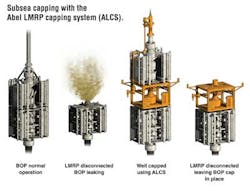Capping stack technology moves forward
Thomas Macrae BSc
L. William Abel, PE
Abel Engineering LLP
In the wake of the Macondo incident in the Gulf of Mexico, Montara offshore Australia, and similar events, the industry has reacted by providing API standards for capping stacks, and studies such as the GIRG Capping and Containment report have been undertaken.
To fill a need for capping technology, Abel Engineering developed a proprietary capping stack (ALCS) whose primary function is to stop the flow as quickly as possible. This system adapts a rig's existing lower marine riser package (LMRP); uses existing rig resources; can be kept on location while drilling or within a one-day delivery window; and has minimal rig-specific equipment onboard.
A stand-alone version (ACS – Abel Capping System) has also been developed. Either system can be deployed in one to two days using the rig on site.
In addition, through hydraulic modeling, the Abel system is sized to the worst case anticipated flow possible, which concludes that 11-in. or 135⁄8-in. BOP through-bore is sufficient. Because of this, 18¾-in. BOP equipment is not required hydraulically nor is it necessary for re-entry to the wellbore, since the 20-in. and/or the 16-in. casings are likely to have been set before reaching the depth where the blowout is possible.
Both systems are deployed on drill pipe. They are light in weight for easier transportation and MODU rig up as well as for deployment in harsh conditions. The idea is that the drilling vessel will be ready to accept the system so as to minimize time spent in rig up and testing for deployment. Running the system on drill pipe optimizes the priority process of using the rig pumping and mixing systems to immediately control the well after capping. This is accomplished much in the same manner as conventional well control, by utilizing the drillstring rather than the kill line as a pumping conduit.
The LMRP version, for instance, can be kept onboard in two 20-ft long (6-m) containers. It can be deployed in the time it takes to pull the riser, plus the time required to install (12 hrs or less) the capping equipment onto the LMRP. This system is also designed so that it can be disconnected leaving the upper mandrel ready for a re-entry via an HP riser system if so desired. This system, with rig support, requires no more than two days to cap and stop or choke back the flow. Capping stack specifications are a 15,000-psi shut-in capacity; 10,000-ft (3,048-m) water depth; 200,000 b/d of oil and/or 500 MMcf/d gas flow rates (or any combination up to those flow rates); and to flow on diversion for as long as 21 days without fear of erosion of the components.
In operation, this capping stack is powered from pre-charged accumulators that can be recharged by an ROV; uses acoustic as the primary operating system with ROV operated panel as secondary; has ROV or acoustic upper connector emergency disconnect; has an on/off by rotation DP disconnect; and includes chemical injection for hydrate treatment, both visual and acoustic temperature and pressure read-outs at critical points. In this way, kill operations can be accomplished with acceptable risks after the well is capped.
Advantages to the Abel LMRP capping system include:
- Available to the rig quickly
- Onboard during operations (2 x 20-ft containers)
- Deployed in time it takes to pull the riser plus 12 hrs to install the LMRP
- Easy to transport and no heavy lifts
- Relatively low cost
- Ability to disconnect and re-enter
- Saves time and reduces exposure.
The ALCS and the ACS are rated for:
- 15 kpsi shut in
- 10,000 ft (3,000 m) water depth
- 200,000 b/d of oil flow rate
- 500 MMcf/d gas rate
- Any combination of oil/gas flow max oil 200,000 b/d of oil and max gas 500 MMcf/d
- Flow on diversion (if needed) up to 21 days.
In today's oil and gas business, contingency capping capabilities are required worldwide to protect the environment from the potential harm of a hydrocarbon release. Training and contingency planning is an essential part of the drilling process, and should be in place before operations begin.
Exposure to risk is huge and is extremely expensive when things go wrong. Therefore, the ability to minimize the exposure time of the incident is crucial. Systems such as the ALCS and the ACS are a fast and effective recovery tool for deepwater drilling incidents involving subsea problems with BOPs and wellheads. They can be adopted by the contractors at the new build stage and incorporated into the deepwater rig design.

